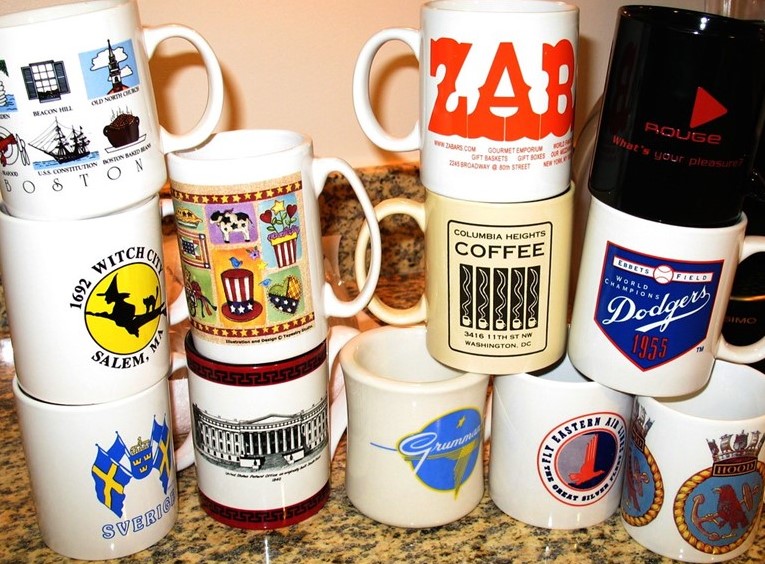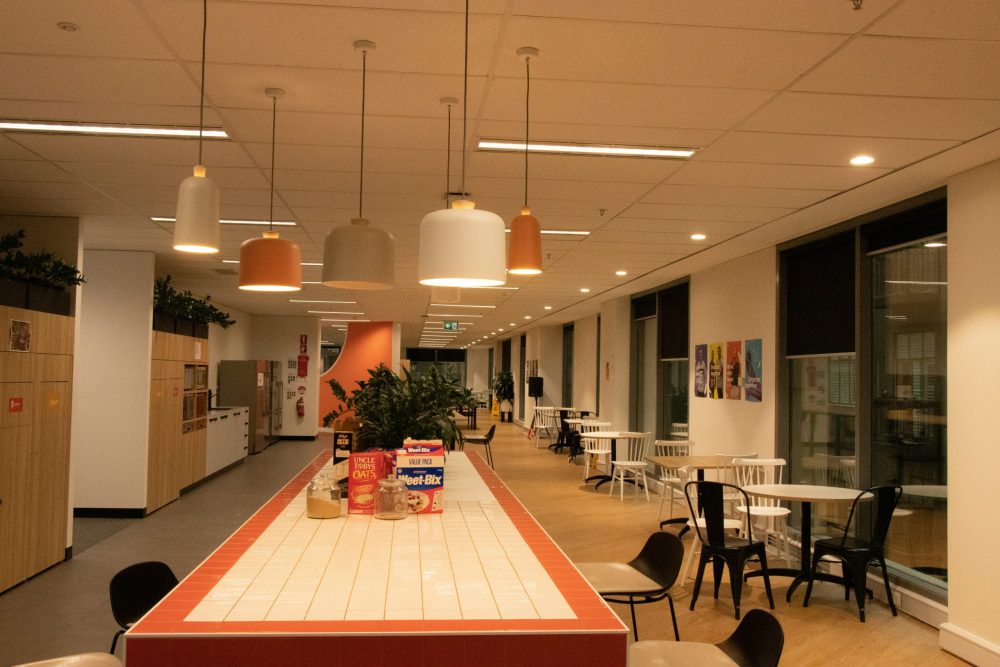Cynthia Milota, Work Design Circular Economy Editor, outlines strategies to make the office café align with circular economy principles. Circular operations are not about reducing waste. They are about designing a system where waste is not created in the first place.
Make the operations of your café and food service as sustainable & circular as the design, material selection and construction of the space.
An office’s café is more than a space for a coffee break, it drives community and reflects the values and essence of the organization. Let’s examine three operational categories for the integration of circular economy strategies into the office café and the hospitality served there: food/beverage, supplies and protocols.
Food/Beverage Considerations
Whether it’s called the café, canteen, break room, bistro, hub or grab n’ go, the office’s hospitality space does more than serve food and beverages. It is a place for breaks, lunch, meetings, presentations, special events and maybe even lunch n’ learns, pop-up shops or art shows.
Here are some strategies to make your food beverage services more circular.
The average US worker makes about 2 pounds of waste per day in the office and 1 pound of that is food waste.
— Sy, 2023
Quick Ways to Reduce Food Waste
Food waste is the number one material in America’s landfills, accounting for 24.1% of all municipal solid waste, (Cooper, 2023). Food waste in the office is predominately created by catering. Here are some strategies to reduce waste and improve experience.

- Right size catering orders and eliminate box lunch roulette. For example, I want the tuna but not the chips in that particular box.
- Provide food contents and nutritional information.
- Know what’s on that sandwich before you take it.
- Eliminate the fear of allergic reactions or dietary restrictions.
- Offer whole fruits rather than cut them up.
- Hire a third-party firm to manage and pick up your office’s food waste.
- In an office of 50, assuming 25 people show up each day, that equates to about125 pounds of food waste per week and over 6,000 pounds of food waste per year.
Employees who opt for predominately unhealthy food choices are 66% more likely to be less productive than those who actively make healthy choices
— Merrill, 2023
Think: Mindful Food
Sure, we can still sell candy bars and chips in the back but offer the healthier options front and center. Include smaller portions for smaller prices, and a variety of special diet offerings.
- Offer meatless or salad only days.
- Make fresh fruits and vegetables low priced and visually appealing.
- Limit unhealthy snacks availability.
- Institute healthy eating programs with incentives for smart food choices.

Pay Attention to Packaging
Offer products with minimal or compostable packaging. Does that apple or in-house made cookie need to be sealed in plastic wrap? Here are some ideas:
- Provide filtered water stations everywhere while eliminating or reducing the number of plastic water bottles.
- Provide self-serve snacks from glass containers to eliminate snack packaging.
- Gift employees swag water bottles and coffee mugs for use in the office.
- Offer discounts to bring your own mug or cup for coffee or fountain beverages.
For a deeper dive on food in the workplace, check out the WELL Standard: Nourishment. Features of this concept include information on food types, ingredients, nutritional information, food advertising and service sizes.
The average US office worker uses 500 disposable coffee cups per year and countless sugars, creamers and stirrers
— Roadrunner, 2024
The Impact of Supplies
We know Styrofoam cups are bad with a 500-year life span in a landfill, and reusable coffee mugs are good. But what other supplies can prevent our office kitchen from generating more waste? Consider:
Banishing Single Use Items
- Reusable dishes, glassware, mugs and silverware are an easy first step. But, a common mistake is to only have 8 of everything for a 25-person office. By midday, much of it will be in the dishwasher. Have enough.
- Inventory compostable cups, plates, bowls and silverware for overflow days.
- Purchase compostable paper napkins and paper towels.
- Conventional napkins and paper towels are not recyclable because their fibers are too short, as most are made from already recycled paper.
- Conventional paper napkins and towels are less compost friendly because they contain bleach and other chemicals.
- Offer an array of spices (including salt/pepper), hot sauces and sweeteners in refillable dispensers.
- Set up refillable cleaning products, sponges and washable cleaning clothes.
Making Sustainability Accessible
- If single use coffee k-cups, capsules or pods are an integral part of your office coffee culture, then make the recycling of them easier. Some brands offer a recycling program that can be integrated into the café space. Others may be recycled by the local municipality. Check out this exhaustive Consumer Reports Guide on recycling coffee pods for more information (Wroclawski & Bradley, 2024).
- Keep a variety of reusable containers for leftovers: for employees to take home or for snacks/lunch the next day.
- Stock the drawers with various knives, a pizza cutter, glass serving dishes, spoons and ladles.
- Have an assortment of hot pads, potholders and dish towels, to reduce the disposable paper towel usage.
If there was just one of these ideas to tackle, let it be the reusable coffee cups. Paperboard cups with leak-proof plastic liners are generally not recyclable, due to the complexity and expense of separating the paper from the plastic liner (Roadrunner, 2024). Make coffee mugs a part of your coffee culture.

About 40% of actions people perform each day aren’t actual decisions, but habits.
— Duhigg, 2010
Key Protocols
People are creatures of habit. By establishing a strong infrastructure for reducing waste in the corporate café, smart choices will become routine habits. Here are some change management strategies and cultural practices to normalize into “no waste” habits.
Education
A blue bin under your desk does not ensure that the building actually recycles.
Establish catering guidelines, which can include:
- Directing the caterer not to supply disposable products.
- Utilizing the company’s serving vessels, rather than throw away plastics.
- Requiring food and nutritional labeling.
- Discouraging box style lunches.
- Simplifying the process of what waste, recycling products and food types go into which container with excellent graphics and signage.
- Encouraging people to take home leftovers in the reusable containers provided.
Check out these complete guides for reducing waste in catering: Event Catering Food Waste Reduction Guidelines and Preventing Problematic Event Waste.

Infrastructure
- Confirm that the building does indeed recycle. That can be easily done by chatting with the housekeeping staff or by contacting the building management.
- Set up a composting program with a third-party vendor. Companies like Compost Now will size your containers, establish a pick-up schedule and provide impact reports.
- Position your recycling, landfill and compost bins in an easy to access place with the traffic flow out of the café space.
- Make it easy to stow your reusables into the dishwasher(s) or trays to be taken back to the main kitchen.
- Establish connections with local community groups and food pantries for easy donation of extra food.
It’s not a space, it’s an experience.
—Nicole Zack, 2024
A little work at the front end, setting up the education/change management and infrastructure, will improve the quality of the experience, while reducing waste.
The culture of hospitality is different for every organization. The opportunity to operate a more circular food / beverage offering in your organization’s café is attainable by reducing food waste and packaging; being more mindful with food offerings; eliminating single use items including plastics; making it a habit to reduce waste. Establishing protocols, continuing education and providing the right infrastructure will heighten your café’s hospitality experience.
References
Cooper, R. (2023). “Food Waste in America: Facts and Statistics.” Retrieved from: https://www.rubicon.com/blog/food-waste-facts/
Duhigg, Charles. “The Power of Habit: Why We Do What We Do in Life and Business.” New York: Random House, 2012.
Merrill, R. (2023). “Exploring the link between productivity and food in the workplace.” Retrieved from: https://www.wellright.com/resources/blog/exploring-the-link-between-productivity-and-food-in-the-workplace#:~:text=Nutrition%20plays%20an%20integral%20role,also%20enables%20employees%20to%20enjoy:
Roadrunner. (2024). “The Facts: Office Workers and Their Waste Generation.” Retrieved from: https://www.roadrunnerwm.com/blog/office-worker-waste-generation#:~:text=GENERAL%20WASTE,waste%20service%20doesn’t%20accept.
Sy, J. (2023). “Guide to Office Waste Facts and Figures.” Retrieved from: https://www.unsustainablemagazine.com/guide-to-office-waste-facts-figures/#:~:text=Global%20Office%20Waste%20Statistics,-North%20America%20is&text=A%20typical%20office%20worker%20will,%2C%20plastic%2C%20and%20food%20waste.
Wroclawski, D & Bradley, M. (2024). “The Ultimate Guide to Recycling K-Cups, Nespresso Capsules and Other Coffee, Pods.” Retrieved from: https://www.consumerreports.org/home-garden/recycling/recycle-k-cups-nespresso-capsules-coffee-pods-a3276889649/

